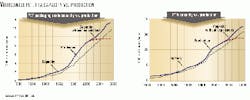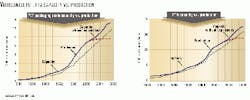Global polyester and intermediates utilization rates will exceed 100% of nameplate capacity by 2007 if worldscale plants are not built, according to a study of polyester and paraxylene by Tecnon (UK) Ltd., London.
In addition, new paraxylene capacity of 2.25 million tonnes/year-about five or six world scale plants-will be needed by 2007 to meet forecast demand growth, according to the report.
Polyester, paraxylene
The world average capacity utilization rate for purified terephthalic acid (PTA) is expected to approach 90% by the end of 2000. "PTA growth prospects are underpinned by its use as the preferred feedstock for polyester fiber, PET [polyethylene terephthalate] packaging resin, and, increasingly, film. DMT [dimethyl terephthalate] consumption growth is forecast at 1.7%/year to 2007 and could be less if polyester capacity rationalization takes place among the older, DMT-based units. PTA demand growth is forecast to average 6.5%/year to 2007," Tecnon's report noted.
In the near term, a glut of paraxylene capacity is expected to hang over the market. Of the 3 million tonnes/year of new paraxylene capacity that has or will come on stream from mid-1999 to mid-2000, most will come from Asia-nearly half from India's Reliance Petroleum Ltd. alone. Meantime, paraxylene consumption growth is averaging only 1 million tonnes/year. So unless other capacity is shut down-or demand exceeds a projected 6%/year average-the world average paraxylene capacity utilization rate will drop below 80% in 2000 and remain there until 2002.
"Of course, plant closures could improve market prospects in the short term, but 1.5 million tonnes/year of capacity would have to be idled in 2000 to achieve an 85% capacity utilization rate, and a further million tonnes would have to go to reach 90%," Tecnon reported.
"The facts that paraxylene margins are expected to remain low and that new MEG [mono ethylene glycol] capacity in 2000 should lead to more-relaxed prices will help PET, PTA, and DMT producers pick up the lion's share of any margin that develops in the chain," Tecnon said.
Capacity outlook
However, beyond 2000, there are few confirmed plans for new paraxylene plants.
Even with the current capacity overhang, Tecnon predicts that the 2.25 million tonnes/year of new capacity needed to meet demand by 2007 may not ease projected market tightness: "Even if this is forthcoming, the world average capacity utilization rate in 2007 will be over 92%. This compares with over 95% in 1995-the last 'peak' in the market. Without any of this 'new' capacity, paraxylene utilization rates will move above 90% during 2004, pass 95% during 2005, and exceed 100% of nameplate capacity by 2007.
By 2007, 12-15 new worldscale PTA plants will also be needed-representing a minimum of 6 million tonnes/year of new capacity-to cover the forecast increase in demand. If all these plants were built, then the world average utilization rate for PTA would be over 95% in 2007 compared with 94% in 1995.
Tecnon's report noted that "A measure of the more immediate problems facing the industry is that without 1.5 million tonnes of new capacity in the next 2-3 years, [PTA] utilization rates will exceed 95% of capacity by[first half] 2003."



